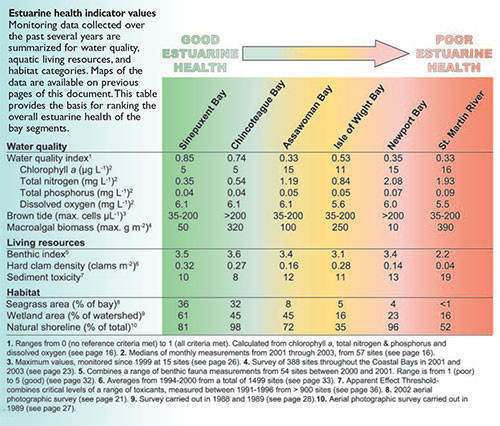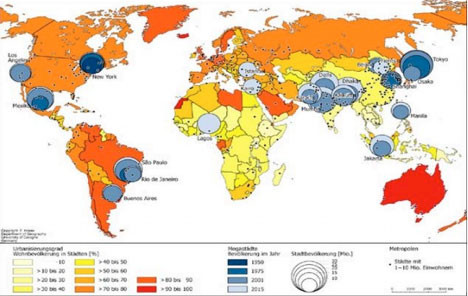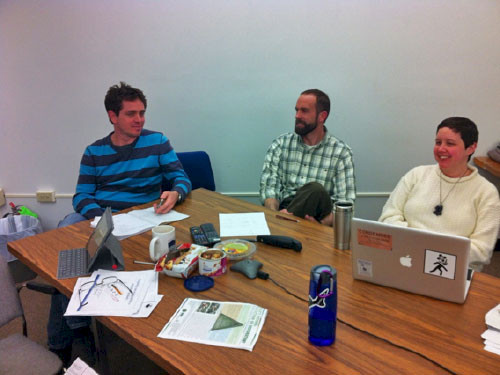The role of science in environmental management case studies along a population gradient
Jia “Claire” Gao, Miaohua Mao, Dale Booth ·The management objectives for achieving ecosystem health can be divided into ecosystem objectives, water quality objectives, and human health objectives (Pantus and Dennison 2005). Different population sizes result in different environmental issues and ecosystem management objectives. Therefore, the way of approaching management objectives vary based on different population sizes. In this essay, we compare five case studies along a population gradient (in increasing population size): Palau, Chincoteague Bay, Moreton Bay, Chesapeake Bay, and Asian megacity. Each of these case studies represents a specific scale of population size.
Palau is an island archipelago in the western tropical Pacific Ocean on a large shallow water platform with a population of 21,000. On one hand, Palau still has intact ecosystems that are healthy. On the other hand, soil erosion from roads and development lead to increased sedimentation, affecting mangroves, seagrasses, and corals. Hence, Palau has come to a crossroads— protecting its intact ecosystems or facing a scenario of costly restoration programs in the future (Figure 1). Fortunately, Palau has been at the forefront in establishing marine protected areas (MPAs) (Protecting Palau’s Natural Heritage newsletter). Palau’s relatively intact ecosystems makes protection a cost effective alternative to costly restorations in the future. In terms of research, systematic knowledge of ecosystem protection and identification of sediment and nutrient sources are priorities. In the case of environmental monitoring, terrestrial monitoring, water quality monitoring, and marine monitoring, would help to record evidence and collect data, which would keep track of ecosystem health condition and benefit science.

Maryland Coastal Bays (which includes Chincoteague Bay) are shallow productive coastal lagoons with a small coastal watershed (453 sq. km), where populations vary seasonally from 22,000 to 250,000. Shallow water depths, limited tidal exchange, and low river input & high ground water inflow make it highly sensitive to human impacts, such as diffuse nutrients from agriculture inputs and wastewater treatment plants. Eutrophication resulting from nitrogen and phosphorus is the main problem of coastal bay water quality. Therefore, nutrient source identification is an important objective both for restoration research and monitoring. Figure 2 shows the estuarine health indicators and the ranking of overall estuarine bay health of the Maryland Coastal Bays. Based on the monitored data and these ecosystem criteria, it could provide the basis for the decision makers to decide which segments need to be restored and protected. Coastal lagoons worldwide are experiencing similar degrading trends due to increasing human pressures, and assessing status and trends relative to biologically relevant thresholds can assist in determining monitoring and management priorities and goals (Wazniak et.al. 2007).

Moreton Bay, on the east coast of Australia, is a shallow productive embayment formed by large sand barrier islands with an approximate population of two million. The principle environmental issues of Moreton Bay are the nutrients, sediments, and toxicants. The nutrients are generated mostly from treated sewage and agricultural runoff (Pantus and Dennison, 2005). Suspended sediments and nutrients can make water turbid and thus reduce available light. Nutrients and light are the two main factors that limit aquatic primary productivity .
Chesapeake Bay is the largest estuary in the United States with a large watershed (64,000 sq. miles) and many tributaries (Figure 3, Kemp et.al. 2005) with a population of 17 million. Fresh water runoff and exchange with the ocean provides potential for stratification, which can result in hypoxia when large nutrient loading occurs. Much more agriculture and industry are present in this watershed, by which more toxicants and sewage are discharged into the bay. So research and monitoring on source identification, hypoxia, and sedimentation are necessary for Chesapeake Bay.

A megacity is defined in terms of metropolitan population size, reflecting the idea that huge size incurs the risk of severe problems in metropolitan management and in absorption capacity relative to the annual average growth of population (especially when the migration component of population growth is high) (Brennan et.al. 1989) (Figure 4). Environmental issues are more severe in megacities because the rate of population growth is too fast for research and management to keep up with. Moreover, the industrialization and large population density make megacities highly vulnerable to disturbance, such as ecocatastrophe and storm surge. In aspects of research and monitoring, topics should lean to public health rather than water quality.

From small scale to large scale in terms of population, more restoration should be done compared to protection. Table 1 shows how the role of science (including research, monitoring and modeling) changes as population size increases. From small to large population, research targets change from basic knowledge to engineering aspects. More attention is drawn from ecosystem health to public health. People’s concerns switch from existence of issues to solutions of issues. Moreover, management cooperation seems to be more complex and hard to be accomplished as population scale increases, since nonexistent political motivation, bureaucracy, and corruption would discourage a community’s willingness for concrete action (Sekovski, et al., 2011).
| Examples of different population size |
Environmental issues |
Research | Monitoring | Modeling |
| Palau | erosion; sedimentation | basic knowledge and system description of ecosystem protection | event sampling | Exorabilitymodel |
| Chincoteague Bay | eutrophication | source identification; land use management | nutrients and primary producers | Eutrophication model |
| Moreton Bay | sedimentation;nutrients | event sampling(e.g.: river run off after storm) | Sediment and nutrient transport model | |
| Chesapeake Bay | Hypoxia; sedimentation;nutrients | Source identification | dissolved oxygen | Hydrodynamic model |
| Megacity | public health(air, water, food) | Bioaccumulation; | food safety; toxins; fish quantity; air quality | Public health model |
Table 1 Issues differ for different estuarine areas as population size increases

References
Dennison, W.C., Longstaff, B., and Thomas, J.E. (2007) Protecting Palau’s Natural Heritage newsletter IAN Press. 3pp.
Fertig, B., O’Neil, J.M., Beckert, K.A., Cain, C.J., Needham, D.M., Carruthers, T.J.B., and Dennison, W.C. (2013) Elucidating terrestrial nutrient sources to a coastal lagoon, Chincoteague Bay, Maryland, USA. Estuarine, Coastal and Shelf Science 116 (2013): 1-10.
Pantus, F.J. and Dennison, W.C. (2005) Quantifying and Evaluating Ecosystem Health: A Case Study from Moreton Bay, Australia. Environmental Management 36 (2): 1–15.
Wazniak, C.E., Hall, M.R., Carruthers, T.J.B., Sturgis, B., Dennison, and W.C., Orth, R.J. (2007) Linking water quality to living resources in a mid-Atlantic lagoon system, USA. Ecological Applications 17: S64-S78.
Kemp, W.M., Boynton, W.R., Adolf, J.E., Boesch, D.F., Boicourt, W.C., Brush, G., Cornwell, J.C., Fisher, T.R., Glibert, P.M., Hagy, J.D., Harding, L.W., Houde, E.D., Kimmel, D.G., Miller, W.D., Newell, R.I.E., Roman, M.R., Smith, E.M., and Stevenson, J.C. (2005) Eutrophication of Chesapeake Bay: historical trends and ecological interactions. Marine Ecology Progress Series 303 (21): 1-29.
Brennan, E.M. and Richardson, H.W. (1989) Asian megacity characteristics, problems, and policies. International Regional Science Review 12 (2): 117-129.
Sekovski, I., Newton, A., and Dennison, W.C. (2011) Megacities in the coastal zone: Using a driver-pressure-state-impact-response framework to address complex environmental problems, Estuarine, Coastal and Shelf Science 96 (1): 48–59.
Authors
First author: Jia Gao Second author: Miaohua Mao Reporteur: Dale Booth
Next Post > Top ten bird symbols: Kookaburras, flamingos, geese and tropicbirds
Comments
-
Bill Nuttle 13 years ago
You make some interesting observations about the how the emphasis shifts from protection to restoration and changes in the role of science along a gradient in human population. However, in every case study, I think, the basic problem is the same; human activities in the watershed affecting the ecological health of downstream estuarine waters. How might your results differ if you examined the response to problems raised by climate change and/or accelerated sea level rise? A different way of asking the same question - is human population as important to understanding differences in the vulnerability and response of estuarine ecosystems to climate change?
-
Melissa 13 years ago
This is a good summary of A LOT of info and has a strong concluding paragraph.
-
Yini Shangguan 13 years ago
It is a neat summary of how environmental problems and management focus might be changing along the human population gradient. Frankly, I have benefited a lot from considering that size matters, which I have never thought of before when comparing different ecosystems. So instead of comparing lagoon vs river-dominated estuaries, tropical vs temperate ecosystems so on and so forth, now I have a new view on ecosystem comparison.

